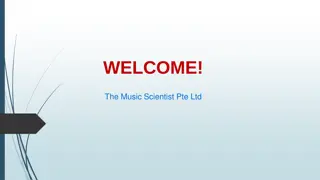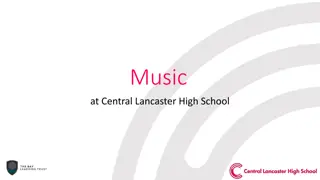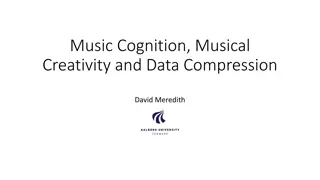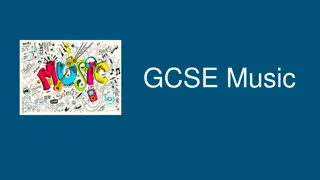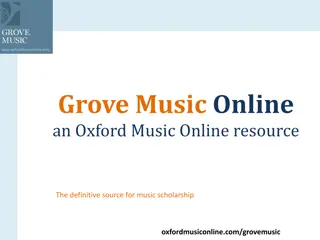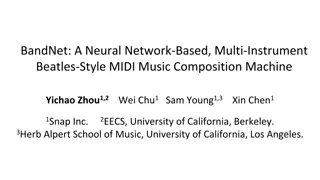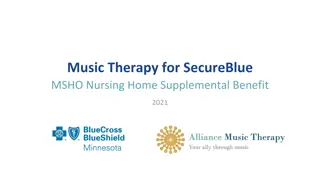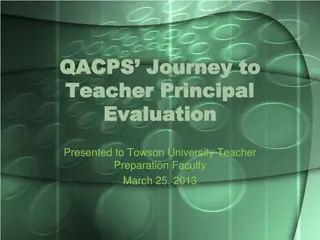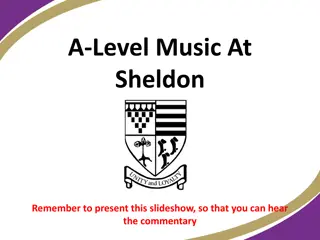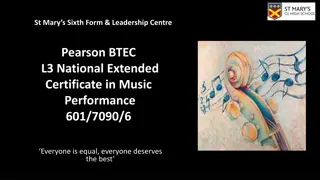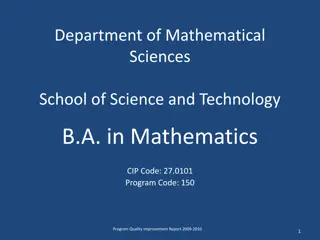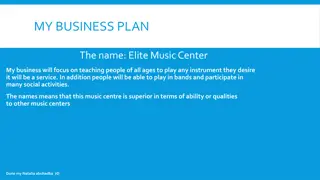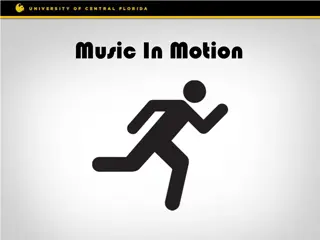Cameron University Department of Music Program Evaluation 2010-2011
This report outlines the learning outcomes, alignment with Bloom's Taxonomy, and program goals of the Bachelor of Arts in Music program at Cameron University Department of Music for the academic year 2010-2011. It discusses educational objectives, student-centered curriculum, faculty initiatives, and strategies for improving student retention and learning outcomes.
Download Presentation

Please find below an Image/Link to download the presentation.
The content on the website is provided AS IS for your information and personal use only. It may not be sold, licensed, or shared on other websites without obtaining consent from the author. Download presentation by click this link. If you encounter any issues during the download, it is possible that the publisher has removed the file from their server.
E N D
Presentation Transcript
Cameron University Department of Music School of Liberal Arts Bachelor of Arts in Music (160) CIP Code 500901 Fall 2010 Program Quality Improvement Report 2010-2011
Learning Outcomes (Items in bold are chosen outcomes) 1. To become aware of, organize, recognize, listen to, assimilate, and respond to factual knowledge of music literature and history through its cultural and historical perspective; 2. To recognize, identify, analyze, and re-create concepts related to sequential music theory including developing music notational skills on a computer utilizing the appropriate software; 3. To perform and develop the basic utilization of fine motor skills related to keyboard skills and conducting and the chosen major field of applied study; 4. To perform skillfully and develop appreciation for accompanying and large ensemble performance while experiencing a variety of repertoire.
Blooms Taxonomy All learning outcomes are directly linked to Bloom s taxonomy of educational objectives. Most music students come into the program with the intense desire to learn and become better artists. Most music courses offer a blend of all three major areas of Bloom s taxonomy. 1. Affective: Great care is taken in the first 2 years of a music student s academic career. We have developed standardized testing and curricula to insure that each student is able to receive the same knowledge, organize it, and set a standard value. There is consistency in text usage, adherence to NASM standards and clear rubrics for Junior standing. 2. Psychomotor: These skills are critically honed in the private studio and piano classes. 3. Cognitive: As mentioned earlier; theory, piano, and sight singing classes are offered in an order that allows the student to remember, understand, apply, analyze, evaluate, and create materials and information from their Freshman to Senior years.
Alignment of Program Outcomes 1. The University Mission Statement: The Bachelor of Music program is designed in accordance with NASM accreditation to prepare students for professional success and the tools for life-long learning. The program is one of the most important aspects of this region s cultural lifestyle. In addition, the faculty are devoted to a curriculum that is student- centered. All teaching classrooms have state-of-the-art equipment in line with the University mission statement. 2. The University Strategic Plan 2013: The Strategic plan addresses issues of new educational partnerships, improved course delivery, and enriching the educational, cultural, and social life of the region. The plan also address the desire to achieve or exceed the Oklahoma State Regents for Higher Education s target retention and graduation rates for Cameron University. We intend to address the methods of improved course delivery in this presentation. The Bachelor of Music program enriches the community as previously mentioned in the university mission statement. In addition, the Chair of the Music department has initiated an extensive program that involves the faculty with all the regional music teachers in an effort to improve recruitment and outreach. 3. Program Outcomes and our Students: It is the department s main goal to enrich and improve the instruction of our students. Recent innovations and changes in curriculum are all geared to improved student retention and learning. We believe that it will take time for these improvements to be noticeable but some empirical evidence will be presented that suggests that our actions are working.
Alignment of Program Outcomes 4. The School of Liberal Arts Mission Statement: The School of Liberal Arts mission statement is closely aligned with the Department of Music. The Bachelor of Arts degree will supply our community with students that will encourage culture and scholarship in the community as teachers and mentors. These same students will produce concerts, recitals, theatre productions, art exhibitions, lectures, symposia, workshops, camps, and public forums which will enrich the intellectual and cultural lives of all our constituents.
Department of Music Measures of Student Learning For B.A. in Music Degree Direct 1. Semester Evaluations (private studio) 2. Junior Standing Barrier 3. Pre- and/or Post-testing 4. Exit Exam for graduating Seniors 5. ETS Major Field Test for Music (new for Fall 2010) Indirect 1. Alumni reports
Program methodologies to address shortfalls in student learning prior to graduation 1. Music Fundamentals (classroom and online) 2. Semester evaluations 3. Faculty and student tutoring 4. Music notation workshops 5. Assigning and tracking midterm grades to identify students with shortfalls (proposed)
Program actions since last assessment presentation Action Plan #1. To increase student achievement in core theory classes, Music Fundamentals was offered as a regular class along with an online component during the Spring and Summer semesters. Increased efficiency of testing for incoming Freshmen was implemented to identify deficiencies and insure proper placement. 1. Initial achievement in Harmony and Structure I classes looks promising. This indicates a probability of better student performance in progressing through core classes and a higher retention rate. Subsequent multi-year tracking will provide additional data to substantiate this action. Enrollment in and pass rate in Music Fundamentals was higher after adding the classroom section. Testing of incoming Freshmen was better. All scholarship applicants were tested and properly placed. Issues with Banner prevented this from being implemented for all Freshmen. 2. 3.
Action Plan #2. Offer increased counseling and faculty contact to facilitate early identification of students who will be pursuing the BA in Music degree.This should help with accurate classification of students according to degree plans and more accurate data for tracking purposes. 1. Students are notified early and often about establishing accurate degree codes for the degree they are pursuing. Faculty is tracking degree codes through the Registrar s listing and following up with students to ensure accurate listings. Faculty is available to help students follow posted degree plans to aid with timely progression through the plans to graduation. This continues to be an issue as students do not consistently inform faculty and change degree codes with the Registrar s office when they decide to purse another degree plan. 2. 3. 4.
Action Plan #3. Discuss possibility of identifying funds for providing service awards to upper level students to tutor at-risk students. 1. 2. No funds were available to offer students. Theory faculty made themselves available for tutoring and students did utilize this option and showed improvement in achievement.
Action Plan #4. Offer music notation seminar at a slightly later time in the Fall semester to create a higher enrollment number and offer more opportunities for success. 1. Enrollment was lower in the music notation seminar for Fall semester. We will continue to offer the seminar at the later date but improve faculty advisement at enrollment. No direct multi-year data is available at this time, but increased ability to use current notation software should become apparent in student achievement as they progress through core classes and into upper division Theory requirements. 2. 3.
Action Plan #5. Hold auditions at the beginning of every semester for large ensembles to provide a base-line score for improvement. 1. Auditions did occur in some ensembles but not in all large ensembles. We would still like to implement this action plan in all large ensembles beginning with Fall semester. 2.
Program objectives PROGRAM GOAL MEASUREMENT OF PROGRAM OBJECTIVE Methods used to determine validity of measurement instruments Methods used to determine reliability of measurements CURRICULUM AREA OR TARGET AUDIENCE PROGRAM OBJECTIVE Schedule for measurements Measurements #2 To recognize, identify, analyze, and re-create concepts related to sequential music theory including developing music notational skills on a computer utilizing the appropriate software. MUSC 2312, 2332, 3313, 3333 (direct) Pre- and/or Post- testing each semester. ETS Major Field Test in Music. Students who score higher on post-tests enjoy higher retention and graduation rates. AP guidelines. Each semester for pre- and post- tests. MFT in addition to Senior Exit Exam. (indirect) Alumni reports
Learning Outcome #2 To recognize, identify, analyze, and re-create concepts related to sequential music theory including developing music notational skills on a computer utilizing the appropriate software. Program Objectives and Measurements The Bachelor of Arts in Music student will take courses related to the second learning outcome including Harmony & Structure I, II, III, and IV. These classes are measured by a pre- and post-test given each semester. In addition, the vast majority of work is done using the most current music notation software available, currently Finale and Sibelius. The student will take the Major Field Achievement Test upon completion of the core curriculum. This test will supplement the departmental Exit Exam.
Display of Assessment Data and Trend Analysis BA Harmony & Structure Sequence 95 90 85 80 75 70 2005-06 2006-07 2007-08 2008-09 2009-10 88 92 92 79 82 Harmony & Structure I
Display of Assessment Data and Trend Analysis BA Harmony & Structure Sequence 100 90 80 70 60 50 40 30 20 10 0 2005-06 2006-07 2007-08 2008-09 2009-10 NA 92 74 79 73 Harmony & Structure II
Display of Assessment Data and Trend Analysis BA Harmony & Structure Sequence 84 82 80 78 76 74 72 70 2005-06 2006-07 2007-08 2008-09 2009-10 80 75 82 82 76 Harmony & Structure III
Display of Assessment Data and Trend Analysis BA Harmony & Structure Sequence 100 90 80 70 60 50 40 30 20 10 0 2005-06 2006-07 2007-08 2008-09 2009-10 86 66 NA 78 77 Harmony & Structure IV
Display of Assessment Data and Trend Analysis, cont. The data indicates a slight downward trend in the achievement rate in student learning, especially in the first year. This supports the need to pursue our Action Plan including increased testing of incoming Freshmen, offering of Music Fundamentals to those who need it and making peer and faculty tutoring available. On the positive side, the average pre-test to post-test improvement rate for all BA students in Harmony & Structure classes in 2009-2010 was 86%. We continue to make adjustments to the curriculum in accordance with NASM standards and recommendations and faculty assignments have stabilized. A theory area coordinator helps with continuity of curriculum and measurement.
Display of Assessment Data and Trend Analysis, cont. Enrollment Enrollment Numbers (for BA only) 2005-06 Harmony & Structure 1 H&S 2 H&S 3 6 H&S 4 6 No data is available for years left blank. 2006-07 1 2007-08 2 2008-09 4 2009-10 3 1 2 3 3 3 7 6 3 7 1 4 4
Program objectives PROGRAM GOAL MEASUREMENT OF PROGRAM OBJECTIVE Methods used to determine validity of measurement instruments Methods used to determine reliability of measurements CURRICULUM AREA OR TARGET AUDIENCE PROGRAM OBJECTIVE Schedule for measurements Measurements #3 To perform and develop the basic utilization of fine motor skills related to keyboard skills and conducting and the chosen major field of applied study. MUSC 1201, 3612, 3801, 3802, 4801, 4802 (direct) Pre- and/or Post- semester tests; Semester evaluations ETS Major Field Test. Rubrics used in semester evaluations of applied study. Semester evaluations are given by a panel of faculty members. Faculty assessment for departmental performances. Each semester. Junior Barrier Evaluation is given at completion of core classes and at least 4 semesters of applied study. (indirect) Alumni reports
Learning Outcome #3 To perform and develop the basic utilization of fine motor skills related to keyboard skills and conducting and the chosen major field of applied study; Program Objectives and Measurements The Bachelor of Arts in Music student will take a number of courses related to the third learning outcome including Class Piano, Conducting and applied lessons. These classes are measured by a pre- and post-test given each semester. In addition, there are semester evaluations and a Junior Barrier Evaluation by a panel of faculty given for applied studies.
Display of Assessment Data and Trend Analysis Fundamentals of Conducting 105 100 95 90 85 80 75 2005- 2006- 2007- 2008- 2009- 100 95 85 Conducting (BA only)
Display of Assessment Data and Trend Analysis Class Piano IV 95 90 85 80 75 2005- 2006- 2007- 2008- 2009- 90 83 90 Class Piano IV (BA only)
Display of Assessment Data and Trend Analysis Applied Piano 95 90 85 80 75 70 2005-06 2006-07 2007-08 2008-09 2009-10 89 87 78 90 Applied Piano (BA only)
Display of Assessment Data and Trend Analysis Applied Vocal 97 96 95 94 93 92 91 2005-06 2006-07 2007-08 2008-09 2009-10 93 94 96 94 Applied Vocal (BA only)
Display of Assessment Data and Trend Analysis Applied Instrumental 150 100 50 0 2005-06 2006-07 2007-08 2008-09 2009-10 91 95 90 74 71 Applied Inst. (BA)
Display of Assessment Data and Trend Analysis Most of the data in the applied area and class piano indicates a fairly consistent rate of student achievement. The addition of the new rubric for semester evaluation has helped and will continue to be revised to aid in assessment. Faculty will grade departmental performances throughout the semester to aid in assessment data available to applied studio instructors.
Display of Assessment Data and Trend Analysis, cont. Enrollment Numbers (for BA only) 2005-06 Conducting 2 Class Piano Applied Piano Applied vocal 5 Applied instrumental No data is available for years left blank or there were no BA students enrolled. 2006-07 2 2 4 3 2007-08 2 3 2 5 5 2008-09 1 2 4 2009-10 2 1 4 3 5
Program objectives PROGRAM GOAL MEASUREMENT OF PROGRAM OBJECTIVE Methods used to determine validity of measurement instruments Methods used to determine reliability of measurements CURRICULUM AREA OR TARGET AUDIENCE PROGRAM OBJECTIVE Schedule for measurements Measurements 4. To perform skillfully and develop appreciation for accompanying and large ensemble performance while experiencing a variety of repertoire; MUSC 1110, 1111, 1120, 1121, 1141, 3160, 3161 (direct) Semester evaluations Rubrics used in semester evaluations. Departmental performances for accompanying and public performances of large ensembles. Each semester. (indirect) Alumni reports
Learning Objective #4 To perform skillfully and develop appreciation for accompanying and large ensemble performance while experiencing a variety of repertoire; Program Objectives and Measurements The Bachelor of Arts in Music student will take a number of courses related to the fourth learning outcome. These courses will include large ensembles such as Concert Choir, Concert Band and Civic Orchestra. These classes are measured by performance objectives and goals given each semester. In addition, there are semester evaluations given for applied studies.
Display of Assessment Data and Trend Analysis Concert Band 105 100 95 90 2005-06 2006-07 2007-08 2008-09 2009-10 97 98 100 Concert Band (BA only)
Display of Assessment Data and Trend Analysis, cont. Most of the data indicates a consistent level trend in student learning. Accompanying students are assigned other applied students and perform regularly at Area and Departmental performances. Large ensemble assessment includes rehearsal and performance assessments by the instructors. Effort is made to assign appropriate and current literature for study and preparation.
Display of Assessment Data and Trend Analysis, cont. Enrollment Numbers (for BA only) 2005-06 Concert Band Concert Choir Civic Orchestra No data is available for years left blank or there was no enrollment of BA students. 2006-07 2007-08 4 2008-09 3 2009-10 3
Action plan 1. 2. Require testing of all incoming Freshmen for accurate placement. Begin immediately to track assessment records of incoming freshmen in all courses (pre- and post-tests) to follow their progress through the course of study. This should provide invaluable date concerning the correlation between current assessment tools and graduation/retention rates and help to assess the validity/reliability of these tools. Emphasize improved faculty advisement at enrollment to place students in notation seminar that need it. Begin to track anonymous faculty assessment of departmental recitals (including piano majors performing as accompanists). The data will be collected after every recital. Implement the use of the ETS Major Field Achievement Test in addition to the existing Exit Exam. Hold auditions in large ensembles at the beginning of every semester to provide a base-line score for improvement. Identify and allocate funds for a service award to upper division students to tutor at-risk students. 3. 4. 5. 6. 7.
Published information on graduates Academic Year 09-10 Entered Graduate School Working In Discipline Unknown Spring 2010 1 1 0 Summer 2010 0 1 0 Fall 2009 0 1 0 Total 1 3 0 Please provide the headcount for placement of graduates from last Academic Year






